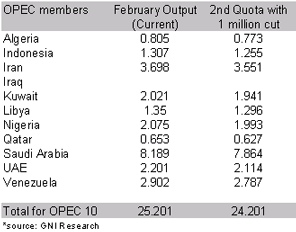|
OPEC to cut quotas
|
 |
March 16, 2001: 2:10 p.m. ET
Oil cartel to reduce output about 1M barrels a day to support prices
|
LONDON (CNN) - Oil cartel OPEC agreed Friday to cut oil production by about a million barrels a day in an effort to stem a sharp fall in oil prices.
 The precise size of the cut, which had been hotly debated at OPEC headquarters in Vienna, Austria, was unknown. OPEC President Chakib Khelil said the ministers had agreed to cut roughly one million barrels a day and were working to settle the exact figure. The precise size of the cut, which had been hotly debated at OPEC headquarters in Vienna, Austria, was unknown. OPEC President Chakib Khelil said the ministers had agreed to cut roughly one million barrels a day and were working to settle the exact figure.
Saudi Oil Minister Ali al-Naimi said the Organization of the Petroleum Exporting Countries would announce the precise amount of the cut within 24 hours.
Oil prices rose immediately after the news was released, with North Sea Brent crude rising 79 cents to $25.80 a barrel and U.S. light crude jumping 68 cents to $27.50.
OPEC tries to support prices
OPEC's goal is to keep the price of a basket of crudes between $22 and $28 per barrel, and it fears production increases it passed in 2000 will lead to a glut of oil as world economic growth slows in 2001, reducing demand for crude.
"This time last year prices were around $32 a barrel before falling to $22 a barrel in May, because of excess supply in the market. OPEC wants to avoid that (happening again this year)," oil analyst Lawrence Eagles at GNI told CNN.
Click here to track oil prices
Eagles said that a million-barrel cut in oil production would stabilize the market price at about $25 a barrel, although "in the short term we could see a knee-jerk reaction higher."
But some observers are concerned about the impact of a production cut on a weakening global economy. The European Commission, for example, called OPEC's efforts ill-timed, given signs of slowdown in economic growth.
Sensitivity to economic concerns
OPEC President Khelil addressed those concerns, saying the group would try to balance its needs with those of its customers.
"We want to meet the demand for countries who are in big economic trouble, and we don't want to create any more pain for these countries in releasing less (crude) than is needed," he said.
|

|
VIDEO
|
|
 CNNfn's Diana Muriel reports on OPEC's agreement to cut oil production. CNNfn's Diana Muriel reports on OPEC's agreement to cut oil production. |
|
Real
|
28K
|
80K
|
|
Windows Media
|
28K
|
80K
|
|
Fadel Gheit, oil analyst with Fahnestock & Co., told CNNfn's The Money Gang program he thought the cut was no higher than a million barrels because Saudi Arabia had convinced other OPEC members that a bigger cut could have a negative impact on the global economy.
"Obviously, if they had cut production more, prices would have probably moved higher, and that would have curtailed economic growth," Gheit said. "They want to make sure they will not be blamed for any economic slowdown in the second half of this year."
Gheit said he thinks demand for oil will continue to fall as the economy slows, which will lead OPEC to cut production again, possibly by as much as 2 million barrels.
Demand, prices have been volatile
There have been a number of significant downward forecasts of expected oil demand. This week the International Energy Agency tweaked its forecast, having performed a similar downward revision earlier this year. Gloomier expectations for the United States, the world's largest economy, have been behind the revision.
Mehdi Varzi, an oil analyst at Dresdner Kleinwort Benson, told CNN that OPEC's 11 members -- Algeria, Indonesia, Iran, Iraq, Kuwait, Libya, Nigeria, Qatar, Saudi Arabia, United Arab Emirates and Venezuela -- are heavily reliant on oil export and need to support the markets "to feed their economies with oil revenues."
OPEC implemented a 1.5 million-barrel output cut in February to counter slowing demand at the end of the northern hemisphere winter.
The cartel, which produces some 40 percent of the world's oil, spent much of 2000 jacking up production to take the steam off prices, which rose to 10-year highs above $35. Some two years ago, the price slumped as low as $10 per barrel.
Under its production agreement, OPEC produces some 25.2 million barrels of oil per day, though Iraqi exports are not included because they are sold under the United Nations sanctions regime.
The cartel has a fractious history, but has managed to maintain a relatively united front over the past two years. Saudi Arabia traditionally takes a softer view of the need to squeeze the oil price higher in these discussions, wary of irritating its ally, the United States. Other countries, such as Iran and Algeria, tend to favor a more hard-nosed approach.
-- from staff and wire reports 
|
|
|
|
|
 |

|

